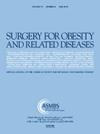GLP-1 受体激动剂与腹腔镜袖带胃切除术后恶心呕吐的风险:一项单中心回顾性队列研究。
IF 3.8
3区 医学
Q1 SURGERY
引用次数: 0
摘要
背景:腹腔镜袖带胃切除术(LSG)术前暴露于胰高血糖素样肽-1受体激动剂(GLP-1 RAs)是否与术后恶心和呕吐(PONV)有关仍不清楚:调查术前GLP-1RAs暴露与LSG术后PONV之间的关系:背景:中国大学医院:我们回顾性分析了2017年1月1日至2021年12月30日期间在南京鼓楼医院接受LSG手术的患者队列,根据患者术前是否暴露于GLP-1RAs分为两组。为平衡两组间的特征,进行了1:1倾向得分匹配。通过逻辑回归确定GLP-1RAs暴露与PONV之间的关系:共有 564 名符合条件的患者接受了 LSG,其中 351 人(62.2%,95% CI 58.2-66.1)出现了 PONV。在所有队列中,72 例(84.7%)术前接触过 GLP-1RAs 的患者和 279 例(58.2%)未接触过 GLP-1RAs 的患者发生了 PONV(调整后的几率比 6.782,95% 置信区间 3.307-13.907,P < .001)。在 158 名匹配患者中,术前接触过 GLP-1RAs 的患者有 66 人(83.5%)发生了 PONV,未接触过 GLP-1RAs 的匹配患者有 48 人(60.8%)发生了 PONV(调整后的几率比为 3.830,95% 置信区间为 1.461-10.036,P = .006)。按剂型和剂量进行的亚组分析显示,无论是每日一次还是每周一次的制剂,剂量越大,LSG术后发生PONV的风险越高:结论:术前暴露于 GLP-1RAs 与接受 LSG 的患者发生 PONV 的风险增加有关,尤其是在暴露剂量较大的情况下。本文章由计算机程序翻译,如有差异,请以英文原文为准。
GLP-1 receptor agonists and the risk of postoperative nausea and vomiting after laparoscopic sleeve gastrectomy: a single-center, retrospective cohort study
Background
Whether preoperative exposure to glucagon-like peptide-1 receptor agonists (GLP-1 RAs) are associated with postoperative nausea and vomiting (PONV) after laparoscopic sleeve gastrectomy (LSG) remains unclear.
Objectives
To investigate the association between preoperative GLP-1RAs exposure and PONV after LSG.
Setting
University Hospital, China.
Methods
We reviewed a retrospective cohort of patients underwent LSG between January 1, 2017, and December 30, 2021 at Nanjing Drum Tower Hospital, dividing the patients into 2 groups on the basis of whether they were exposed to GLP-1RAs preoperatively. A 1:1 propensity score matching was performed to balance the characteristics between the groups. Associations between GLP-1RAs exposure and PONV were determined by logistic regressions.
Results
A total of 564 eligible patients underwent LSG, 351 (62.2%, 95% CI 58.2–66.1) of whom had PONV. In total cohort, PONV occurred in 72(84.7%) patients exposed to GLP-1RAs preoperatively and 279 (58.2%) patients not exposed to GLP-1RAs (adjusted odds ratio 6.782, 95% confidence interval 3.307–13.907, P < .001). In the 158 matched patients, PONV occurred in 66 (83.5%) patients exposed to GLP-1RAs preoperatively and 48 (60.8%) matched patients not exposed to GLP-1RAs (adjusted odds ratio 3.830, 95% confidence interval 1.461–10.036, P = .006). Subgroup analysis by dosage forms and doses revealed a positive association between greater doses and an increased risk of PONV after LSG for both once-daily and once-weekly formulations.
Conclusions
Preoperative exposure to GLP-1RAs is associated with an increased risk of PONV in patients undergoing LSG, particularly at higher doses of exposure.
求助全文
通过发布文献求助,成功后即可免费获取论文全文。
去求助
来源期刊
CiteScore
6.70
自引率
12.90%
发文量
570
审稿时长
56 days
期刊介绍:
Surgery for Obesity and Related Diseases (SOARD), The Official Journal of the American Society for Metabolic and Bariatric Surgery (ASMBS) and the Brazilian Society for Bariatric Surgery, is an international journal devoted to the publication of peer-reviewed manuscripts of the highest quality with objective data regarding techniques for the treatment of severe obesity. Articles document the effects of surgically induced weight loss on obesity physiological, psychiatric and social co-morbidities.

 求助内容:
求助内容: 应助结果提醒方式:
应助结果提醒方式:


